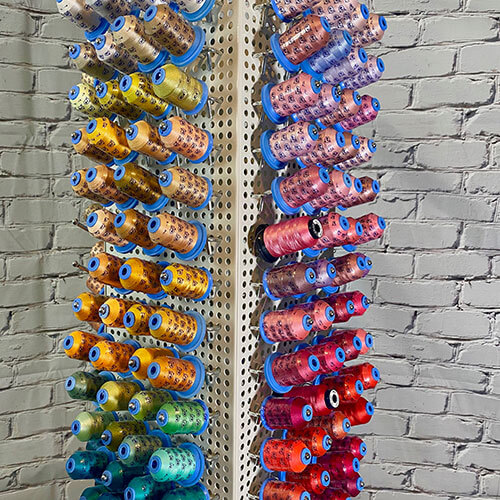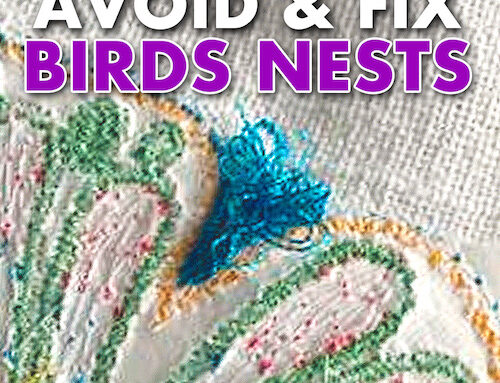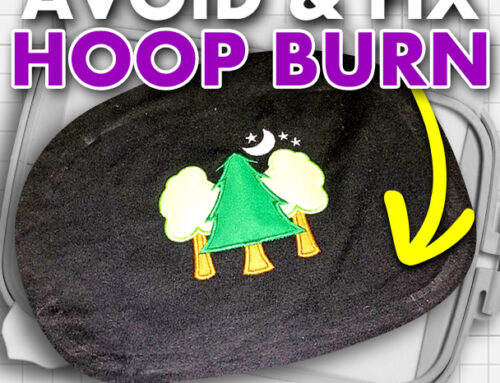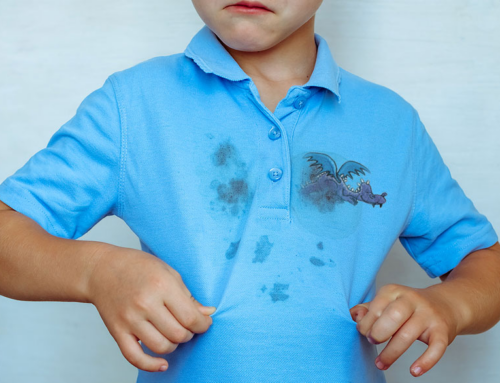Everything you need to know about thread when you’re just getting started
Machine embroidery is exciting, yet daunting for a newcomer. Beginners tend to overlook the importance of understanding the different machine embroidery thread types and how to use them. You’re here because you want to know more, to be better, and to improve your creative knowledge and abilities. You’ve come to the right place. We’ll cover polyester, rayon, cotton, silk, and the slightly notorious metallic threads, and when to apply them in your work.

Think of Embroidery as a Recipe, and Threads as an Ingredient
Before we dive into threads, it is critical to understand that not all threads are alike, and not all machines are alike. Matching thread brand to machine and needle is like finding the perfect recipe. Some thread types and brands will work better with certain machines and needles.
It’s crucial to test your thread on a scrap of fabric first rather than your partners favorite shirt. Ensure that the material you’ll be testing on is the same as the material you’ll use for your project. Order a small amount of thread first for proper testing to see what works best with your machine and your creative intent.
Polyester embroidery thread

Polyester thread has become the industry standard and for a good reason. It is strong, durable, colorfast, and can even withstand chlorine bleach.
Polyester thread provides a sheen that makes your embroidery look professional and feel professional. This thread comes in a wide variety of colors and is known to run smoothly.
It is an excellent choice for general embroidery, especially outdoor clothing or children’s garments. We all know children are mess-free little angels but when they do make a mess, polyester will withstand the cleaning process.
The last thing any embroidery machine wants is a thread that continuously breaks. Your machine will be happy when using polyester thread in your projects. However, a polyester thread shouldn’t be used for all of your projects. I’ll explain further below.
Rayon embroidery thread

Rayon thread is a common choice due to its incredible selection of colors and high sheen, even more so than polyester.
Its only weakness is its strength when compared to polyester. Polyester has a much higher breaking point than rayon. That is why it is essential to test different rayon thread brands with your machine to see how they hold up with stitch intensive designs and high-speed stitching.
Generally, rayon thread still performs well during high-speed stitching. It is softer than polyester and is more suitable for intricate work or work with freestanding lace.
Cotton embroidery thread
Where polyester and rayon pride themselves on a high sheen look, a cotton thread has a beautiful soft sheen. You can order cotton threads with a matte finish to further your creativity. It performs well in most machines, but again, it’s good to test it out to make sure it runs smoothly.
Cotton threads can be purchased in standard thickness, but they also come in very fine varieties, suitable for incredibly intricate and delicate work. Keep in mind that the finer the thread, the more likely it is to break while embroidering.
Silk embroidery thread
Silk is luxurious and sought after in the fashion world, and is considered equally luxurious when it comes to machine embroidery. Silk thread is strong and fine, yet has a sheen and softness that is unmatched by both polyester and rayon.
For these reasons, silk thread can be expensive, and it might be challenging to acquire specific colors. It’s the thread you’ll want to use for high-end projects or embroidering on deluxe fabrics.
Metallic embroidery thread

Ah yes, the thread that keeps on breaking. Metallic threads are notorious for breaking during embroidery and this can cause frustration!
Check out our video on how to change your thread without having to rethread the needle, save the irritation!
Metallic threads provide beautiful colors and shines that other threads cannot emulate, but many new embroiderers are easily frustrated as rethreading your embroidery machine can be a very irritating and time-consuming process.
This problem can be easily fixed with a few adjustments to your spooling technique and by making sure to use a needle specific to metallic thread embroidery. Click here to see a detailed explanation of how you can avoid metallic thread breakage.
Metallic threads are composed of a central core that is wrapped in metals or foils and then dyed with the desired color. These strands tend to fall apart easily, which is where the integrity of the thread seems to fail. Picking up the high-quality metallic threads will reduce breakage when embroidering, and are worth the extra penny.
Here’s a great video from our Machine Embroidery for Beginners Series focused on thread types and tips:
A Brief Lesson on Machine Embroidery Thread Thickness
In the machine embroidery world, thread thickness is referred to by weight. The larger the number, the finer the thread, the easier it will break. Finer threads are good for heirloom quality embroidery, and thicker threads are better for general work.
For example, the standard thickness for rayon thread would be referred to as 40 wt thread. A 20 wt thread would be thicker, and a 60 wt thread would be finer. When choosing thread weight, it all depends on the desired result or purpose of your project.
For high quality, high detail designs over a small surface area, you might use a finer thread. For larger designs, maybe for materials that will be outdoors or in constant use, you might want a thicker thread.
However, in general, 40 wt thread should be your normal go-to as most embroidery designs (including ours) are created with this thread weight in mind.
So What Thread is the Best Machine Embroidery Thread?
If you’re hungry for an answer, it’s polyester. If you’re hungry for the right answer, it’s whatever thread you need to give your project the embroidering integrity and creative genius it deserves. Polyester is an excellent all-rounder, but rayon is more suitable for softer work. A metallic thread might break easily, but it’ll give your piece that additional flair it needs. Silk is expensive, but it’ll add a luxurious look and feel to your projects.
When it comes down to choosing the correct thread for your work, remember to test it first. It is always best to have all the colors you need from a brand you trust. It’ll save you time, money, and headache. To learn more tricks and tips regarding embroidery thread watch our video here.

What is a Bobbin Thread? Why Does it Matter?
Without a bobbin and its thread, you wouldn’t have a stitch. It’s an essential piece of any machine, and you cannot embroider without one. A bobbin is located directly under the needle. When the needle plunges through the fabric, the bobbin wheel creates a loop with your main thread and wraps it around the bobbin thread, then pulls it tight. That’s how you get a stitch.
Bobbin thread can be a different color than your embroidery thread, but you’ll want to be sure it matches or is close to matching the color of your piece. Bobbin thread is seen on the underside of your embroidery, and can sometimes shine through your design. Have you ever turned over some embroidery and seen that the color of the thread on the bottom doesn’t necessarily match the top?
Depending on what you are embroidering, there are a few different options in terms of colors for your bobbin thread. Generally, you want the color of your bobbin thread to match the color or color tone of your piece.
If you are embroidering a dark design, perhaps navy blue or black, you’ll want dark bobbin thread. If you’re embroidering a pale yellow or white, you’ll want a light bobbin thread. You can buy pre-wound bobbin thread in black and white to save time – you won’t have to wind it yourself.
If you want to ensure that your piece is flawless, you’ll want to use the same thread and color for your bobbin as you’d use for your embroidery. It might be hard to purchase pre-wound bobbins with the same thread as your embroidery thread, so you’ll have to wind it yourself. Most machines come with a bobbin winder, but if not, you can order one on Amazon.
P.S. Want to learn more embroidery basics? Check out our complete Machine Embroidery for Beginner’s Guide.
Which Machine Embroidery Thread Brand Do We Recommend?
After testing multiple thread brands over the past 60+ years, we’ve narrowed down our favorites to a few different brands we like best.
Currently, our top brand is Simthread. Although this brand may sound new to you, I can almost guarantee you’ve used their thread in the past… You see Simthread “white-labels” thread for a number of the industry’s most popular brands. So, instead of purchasing thread through one of these other companies and paying a mark-up because of the brand name, ordering through Simthread allows you to go “factory-direct.” Being industry tested for over 30 years now, Simthread comes in a range of beautiful colors and doesn’t break easily.
The best part? It’s also available on Amazon Prime so you can save on shipping costs and get your thread delivered quickly!
Click here to learn more about Simthread using our official sponsor link (if you do end up ordering, please be sure to use this link so we get a small kickback… You’ll also get some free designs as an added bonus!).
Now our second favorite thread would be Robison Anton. Much like Simthread, it comes in a beautiful array of colors and is durable. What sets them apart in our books is that as far as we know, they’re the only thread brand still manufactured in the USA. So if you’re able to spend a bit more, why not support local?
What’s Next? Start Testing Thread on Your Embroidery Machine
Now that you know how and when to better use some of your ingredients, you can start your recipe! Of course, before you can choose your thread type, you have to know what design you’re going to stitch out. But, please keep in mind:
Using embroidery designs that were not digitized properly is one of the main reasons you may experience thread breaks.
For this reason, it’s important that you use quality designs while testing out new thread types on your machine. Here at Embroidery Legacy, we personally guarantee that every embroidery design sold on our site was digitized properly (digitizing is the art of creating embroidery designs using embroidery software). For polyester, cotton, silk, and metallic thread we offer a large selection of close to 30,000 designs. Click here to view our embroidery design categories now. Or if you’re interested in using rayon thread, we offer many freestanding lace designs that were originally created in our family’s embroidery factories back in the 1950s. Click here to view our freestanding lace embroidery designs now.
Happy stitching and please let us know which thread type is your go-to in the comments below!







Can one use bobbin thread for „normal“ embroidery upside? What is the difference between bobbin thread one „normal“ thread?
Hi Heike,
Bobbin threads are usually a lighter weight white poly so I personally wouldn’t use it as a top thread. You can, however, wind the top thread as a bobbin so it is the same color on both sides 🙂
Thanks
🙂
Use always Marathon polyester. But a question is the metallic. Youre tip for the paper cup with pencil, how to use it on a 10 needle brother machine?
Nanny
Hi Nanny, as long as it’s sideways you can place the spool anywhere, the floor/table beside the machine 🙂
Thank you John and family, I have collected quite a few of your designs as well as some exquisite lace designs. I would like to take advantage of the offer for embroideries but the coronavirus has limited my funds.
Our pleasure Vivienne! No problem, I certainly understand. Wishing you and your family good health & safety during this time 🙂
Thank you John for yet another interesting lesson on the types of embroidery threads available.
I am a member of Embroidery Legacy and love to go through your designs. Sometimes I cheat and get a design that intrigues me on how you have digitised it, just to see how it comes together.
Thank you for sharing your knowledge, you don’t know how sane it has kept me through these difficult times. Regards to you and your family.
Our pleasure Gill! Thanks for being a member of our Embroidery Legacy Design Club 🙂
Dissecting how a design was digitized is a great way to learn. I appreciate the kind words & I’m glad we could help keep you busy during these difficult times. All the best to you and your family
Hi, I am very new to machine embroidery. New to sewing actually. Is there a difference between bobbin thread and embroidery thread with machine embroidery? When I go to buy thread do I have to buy two separate types of thread? Also, where is the best place to buy thread? I’m trying to avoid Amazon. I want to support other businesses. Thank you.
Hi Ashanti, you can use the same thread in your bobbin. Yes it’s great to support local! Your local sewing machine dealer can assist you with thread that is best suited for your machine.
Hello what type of thread is good for boat vinyl to add the boat logo? Also for car seats the head rest to add the logo on leather or vinyl? Thanks alot
Hi Justin, I would suggest any Poly thread brand. Poly is much stronger than Rayon. The key for success is for that the design is digitized specifically for leather/vinyl.
I’m new to the embroidery world. What great info
Thank you
Thanks for your support Alice!
I was having trouble with my metallic thread and then came across your suggestion of a sideways thread holder. Works beautifully. I have shared it with my embroidery buddies. Thank you.
Great to hear Kristine! Thanks for reading 🙂
Hi John
only new to all this and I’ve just purchased your lessons oh boy am I having fun and learning lots on how to digitise I can’t wait to learn a lot more from you do you ever do any in person lessons here, I am living here in Ireland as I’d love to go if you have as its a whole new ball game roll on the learning curve 😁❤️
Thanks for your feedback Sonja 🙂 glad to hear you’re enjoying the classes. Unfortunately, my traveling has slowed down lately, so it’s not in any future plans